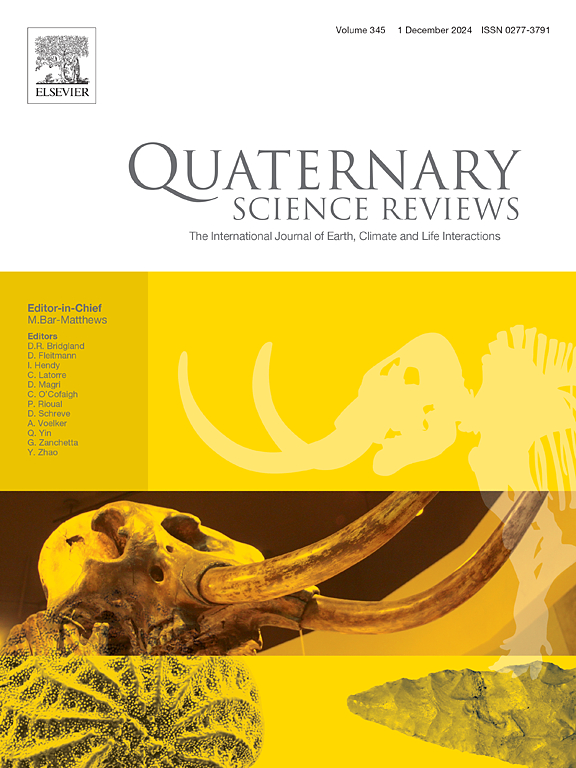Origin and Late Holocene evolution of Lake Morské oko in a climatic and environmental context in the Eastern Carpathians
IF 3.2
1区 地球科学
Q1 GEOGRAPHY, PHYSICAL
引用次数: 0
Abstract
Palaeoecological reconstructions in the Carpathians have primarily focused on the western and south-eastern mountain ranges, leaving a significant gap in our understanding of the central region along the Slovak-Ukrainian borders. This study investigated Lake Morské oko (Vihorlat Mts., Eastern Slovakia), whose origin has been debated. Using a multiproxy approach that combines hydro-acoustic surveys, sedimentological analysis, biomarker-based organic geochemistry, and pollen analysis, we confirm that the lake formed when a landslide from the eastern slopes of Motrogon and Jedlinka hills dammed the Okna valley shortly before 2780 cal a BP, coinciding with a documented wet period across Europe. Our record reveals a remarkably stable lake system that evolved from being dominated by terrestrial organic input to enhanced in-lake production after 1850 cal a BP. Our quantitative temperature and humidity reconstructions, the first in the region, capture major climatic episodes, including the end of the “2.8 ka event”, Roman Warm Period, and Mediaeval Climate Anomaly, during which there was likely increased lake water thermal stratification or reduced connectivity with the catchment. The Little Ice Age period is marked by temperature fluctuations corresponding to the Maunder and Dalton minima. Human influence becomes evident from 1100 and 700 cal a BP through increased Cerealia-type pollen and atmospheric lead deposition from regional mining activities. This study provides a continuous, well-dated Late Holocene palaeoenvironmental record spanning nearly 3000 years from this region of the Carpathians, bridging a crucial gap between western and eastern records while definitively confirming the lake's origin from a landslide.
喀尔巴阡山脉东部气候与环境背景下的莫斯科斯科尔科湖起源与晚全新世演化
喀尔巴阡山脉的古生态重建主要集中在西部和东南部山脉,这使得我们对斯洛伐克-乌克兰边境中部地区的理解存在重大差距。本研究调查了斯洛伐克东部Vihorlat mt .的morskreako湖,其起源一直存在争议。利用水声调查、沉积学分析、基于生物标志物的有机地球化学和花粉分析的多代理方法,我们证实,在2780 cal a BP之前不久,Motrogon和Jedlinka山东坡的山体滑坡阻塞了Okna山谷,形成了湖泊,与记录的整个欧洲的潮湿时期相吻合。我们的记录揭示了一个非常稳定的湖泊系统,在1850年(约a BP)之后,由陆源有机输入主导向湖内有机生产增强演变。我们在该地区首次进行了定量的温度和湿度重建,捕获了主要的气候事件,包括“2.8 ka事件”结束、罗马温暖期和中世纪气候异常,在此期间可能会增加湖水热分层或减少与集水区的连通性。小冰期的特征是与蒙德极小期和道尔顿极小期相对应的温度波动。从1100和700 cal a BP开始,通过区域采矿活动增加的谷类植物型花粉和大气铅沉积,人类的影响变得明显。这项研究提供了喀尔巴阡山脉地区近3000年的连续的、年代准确的晚全新世古环境记录,弥合了西部和东部记录之间的重要差距,同时明确证实了该湖起源于山体滑坡。
本文章由计算机程序翻译,如有差异,请以英文原文为准。
求助全文
约1分钟内获得全文
求助全文
来源期刊

Quaternary Science Reviews
地学-地球科学综合
CiteScore
7.50
自引率
15.00%
发文量
388
审稿时长
3 months
期刊介绍:
Quaternary Science Reviews caters for all aspects of Quaternary science, and includes, for example, geology, geomorphology, geography, archaeology, soil science, palaeobotany, palaeontology, palaeoclimatology and the full range of applicable dating methods. The dividing line between what constitutes the review paper and one which contains new original data is not easy to establish, so QSR also publishes papers with new data especially if these perform a review function. All the Quaternary sciences are changing rapidly and subject to re-evaluation as the pace of discovery quickens; thus the diverse but comprehensive role of Quaternary Science Reviews keeps readers abreast of the wider issues relating to new developments in the field.
 求助内容:
求助内容: 应助结果提醒方式:
应助结果提醒方式:


